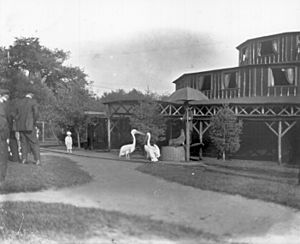Longfellow Zoological Gardens facts for kids

Jones, center, performs with a seal and two pelicans in 1917 at the Longfellow Gardens
|
|
| Date opened | 1906 |
|---|---|
| Date closed | 1934 |
| Location | Minnehaha in Minnesota, United States |
| Coordinates | 44°54′56″N 93°12′53″W / 44.91556°N 93.21472°W |
The Longfellow Zoological Gardens, often called the Longfellow Gardens, was a special place in Minneapolis, Minnesota, United States. It was both a zoo and a beautiful garden located in the Minnehaha neighborhood.
Contents
The Start of the Zoo
The Longfellow Gardens began with a man named Robert "Fish" Jones. He was a businessman and showman from Minneapolis.
Robert "Fish" Jones's Animal Collection
Jones started collecting animals when he arrived in Minneapolis in 1876. By 1886, he bought a property near downtown Minneapolis. He turned this 3-acre (12,000 m2) area into a home for his growing animal collection.
His first animals included:
Opening to the Public
As his collection grew, Jones needed more space. He moved his animals to a larger area in south Minneapolis. In 1906, he officially opened his zoo to the public. He also built a house there. It looked like the home of the famous poet Henry Wadsworth Longfellow. Jones lived in this house for the rest of his life.
In 1908, an important ceremony took place at the gardens. Frank Nye, a Representative from Minnesota, led the event. During this ceremony, Jones and others received a letter. It was from Alice M. Longfellow, the poet's daughter. She wrote that she wished to visit the gardens someday, but she never did.
Amazing Animals at the Zoo
The Longfellow Zoo became very popular. It continued to grow, adding many exciting animals.
Variety of Wildlife
Visitors could see a wide range of animals, including:
- Zebras
- Monkeys
- Orangutans
- A polar bear that was said to have come all the way from Norway
Jones had a professional trainer who worked with the zoo's 8 lions. Sometimes, Jones himself would even go into the cage with them! He was known for how much he cared for his animals.
Birds and Other Creatures
The zoo also had many different kinds of birds. These ranged from the colorful grey crowned crane to the elegant flamingo and tall storks. The zoo was also famous for its seals. One very powerful tiger was part of the collection. It had been personally captured by animal collector Frank Buck in Johore.
The Zoo's Final Years
The Longfellow Zoo continued to attract many visitors. People loved seeing the unique wildlife. Children especially enjoyed the monkeys, which were a big highlight for them.
Challenges and Closure
However, the zoo also faced some challenges. Neighbors often complained about the noise and smells coming from the animals. Despite these issues, the zoo remained a popular spot.
In 1930, Robert "Fish" Jones passed away. His family tried their best to keep the zoo running. Sadly, they were not able to, and the zoo had to close down. Many of the animals found new homes. Some were sold, and others were given to the Como Zoo in St. Paul.
In 1934, the land where the zoo once stood was given to the Minneapolis Park and Recreation Board. There was a rumor that several seals escaped the zoo. People said they went over the Minnehaha Falls and into the nearby creek. However, this story was never proven.
Today, the area where the Longfellow Zoological Gardens once stood is now a residential neighborhood.

